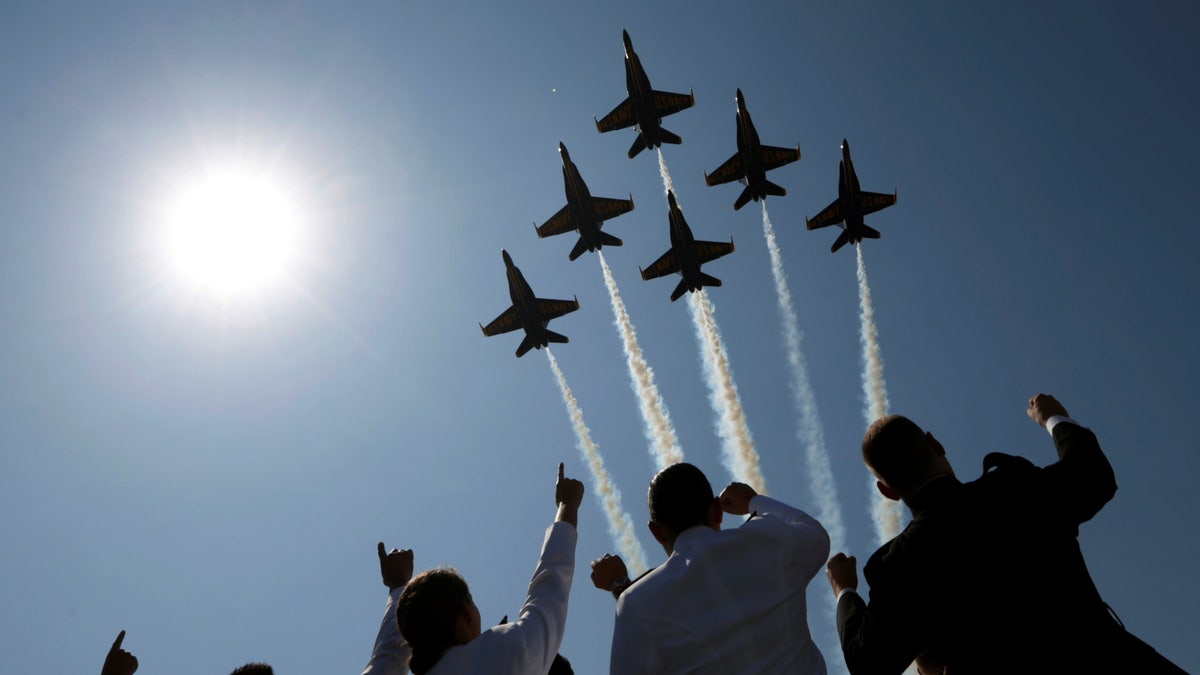
The Blue Angels perform a fly-over at the start of the graduation and commissioning ceremony at the U.S. Naval Academy in Annapolis, Maryland, May 27. (REUTERS/Kevin Lamarque, File)
The world's most powerful naval force -- the United States Navy -- was born from very humble beginnings. Oct. 13 is the Navy's 241st birthday, and it's a chance for all Americans to pay tribute to a hardworking branch of America's military that is always ready to answer the call of duty.
The U.S. Navy traces its roots back to the Revolutionary War, when privateers were hired by the colonies to attack British commerce in the early days of growing conflict with England. On Oct. 13, 1775, the Continental Congress established an official naval force, hoping a small fleet of boats would be able to offset the seemingly intractable sea power of the British.
The early Navy was not formed to wrest control of the seas from Britain, but instead to wage tactical raids against the transports that supplied British forces in North America. The Continental Congress subsequently purchased, converted, and built a fleet of small ships that included brigs, sloops, and schooners.
These navy ships sailed alone or in pairs, hunting British commerce ships and transports.
More From LifeZette.com
Although the Continental Navy was later dismantled, Oct. 13, 1775 remains the U.S. Navy's official birthday.
After the Revolutionary War, the U.S. Navy went on to play a major role in the American Civil War by blockading Confederate armies and seizing control of Southern rivers. The U.S. Navy also played a central role in World War II and the defeat of Imperial Japan.

Japan's delegation gather to sign the formal surrender document on the U.S. Navy battleship USS Missouri in Tokyo Bay in a September 2, 1945 file photo. (REUTERS/US Air Force/Handout via Reuters)
The U.S. Navy currently maintains an impressive global presence, deploying in such areas as East Asia, the Mediterranean, and the Middle East. The Navy is and always has been an important factor in U.S. foreign and defense policy.
To choose the name of a naval ship, suggestions are compiled by the Naval Historical Center based on submissions from the public, sailors, retirees, and from naval history. The Chief of Naval Operations formally signs and recommends the list to the secretary.
Unlike the U.S. Army and U.S. Air Force, the Department of the Navy consists of two uniformed services: The United States Navy and the United States Marine Corps. Collectively, they are referred to as the naval services, or "sea services."
Today's Navy faces challenges -- an America increasingly under threat from enemies, defense budget cutbacks, and even progressive social theory.
On Wednesday, at least one missile was fired from rebel-held territory in Yemen at U.S. Navy ships in the Red Sea -- the second time in four days that such an attack has happened, defense officials said.
The attack was again aimed at the USS Mason, a guided-missile destroyer, said Pentagon press secretary Peter Cook.
Navy hardship pay is under threat, the Navy Times noted Oct. 11. Extra pay for extended deployments was recently approved for one year only -- not the two years the services requested in July. Hardship pay could be cut completely by October 2017 unless the Navy and Marine Corps can justify their effectiveness.
Under this Hardship Duty pay, sailors and Marines are paid an additional $16.50 per day for each day deployed past 220 days, according to the Navy Times.
"The Navy is in high demand and is present where and when it matters," said Vice Adm. Robert Burke, the Navy's chief of personnel, in a written statement to the Navy Times. "Hardship Duty Pay -- Tempo is designed to compensate sailors for the important roles they continue to play in keeping our nation safe during extended deployments around the globe."
All who serve aboard submarines are volunteers and have passed rigorous psychological and physical tests. Those serving on submarines are among the most highly trained personnel in the military.
Culturally, the Navy has just this month fallen victim to the tide of gender-neutral language that's been hitting many American institutions. Navy Secretary Ray Mabus announced the U.S. Navy would deep-six almost 250 years of naval tradition and require members of the navy to address each other by rank. This change began with taking the word "man" out of virtually all titles.
"Beyond a small working group, convened this past summer and led by then-Master Chief Petty Officer of the Navy Mike Stevens, next to no one in the Navy saw this change [gender-neutral language] coming, sources with knowledge of the decision-making process say," the Navy Times reported.
"Yeo-person? There is no such thing," said the master chief petty officer of the Navy.
One word on the chopping block? "Yeoman."
"You can't have yeo-specialist or yeo-technician, right?" Michael D. Stevens, master chief petty officer of the Navy, told The Washington Post. Stevens is tasked with the job of coming up with the new titles. "Yeo-person? There is no such thing."

John Paul Jones during the American Revolution. Hand-colored engraving of a portrait. (North Wind Picture Archives via AP Images)
Through times of certainty and times of change, the Navy stands ready to defend America. No one knows this better than enlisted Navy personnel.
Said Captain John Paul Jones in a letter dated Nov. 16, 1778, "It follows then as certain as that night succeeds the day, that without a decisive naval force we can do nothing definitive, and with it, everything honorable and glorious."
Happy 241st birthday, Navy. You bring honor to your nation.

